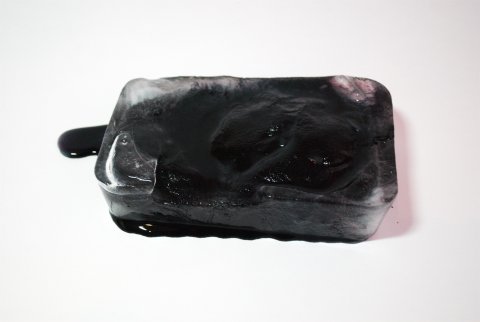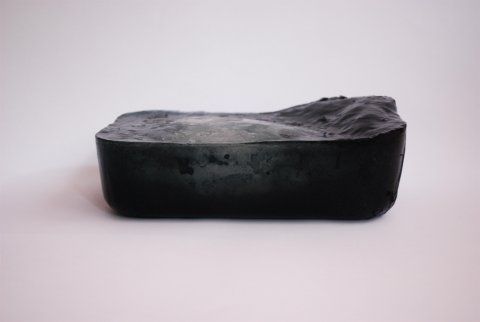


My transcription project was inspired by the Zurbaran painting 'Saint Francis in Meditation', the figure is completely submerged in this infinite black background, whilst holding a skull - which thinkers and philosophers used to remind them of their own mortality. With this series of experiments I combined these two notions, mortality and submerging, to create pieces that tried to capture an ephemeral moment (because in the grand scheme of things, life is ephemeral) - when two or more liquid substances merge together, by freezing them.
These three sculptures each had a different process. Number 1 I half froze a container of water, then poured black food colouring into it, then let it freeze completely. This had a consuming effect, the food colouring overpowered the water, mirroring the background of the painting. With the second sculpture I froze the water completely first, then poured green and black food colouring on top of the frozen surface, the colouring would seep between the crevices of the ice, swaying more towards my concept. The last sculpture had the same process as the previous one, but then it was left out at room temperature for a day and refrozen. All these sculptures were left up to chance, I had a part to play but as Sartre says in Existentialism & Humanism, 'there is no prevenient design'; I could not control the results of these experiments because you cannot control anything which is not within your direct will.

To the extent possible under law, achand1 has waived all copyright and related or neighboring rights to this Work, Submerged.



Comments
I get the impression of there being a taintedness present in your photos which I guess fits in well with your ideas of chance and mortality. It's like the water is utterly pure to me and the food dye is an outside agent of impurity - similar to the idea that we reject mortality from our lives but it is insidious and is fundamentally creeping into our consciousness. That said, the sculptures remind me of blocks of soap, which comes back to the clean/dirty dichotomy and fits into the ephemerality element. Not being an artist though, I cannot positively claim that you have produced something new or challenging, but it is certainly an engaging piece.
Funny you speak about waiting, have you heard of Samuel Beckett's "Waiting for Godot" ? If you were around in the West End early last year and late 2009, you would have noticed those posters with Sirs Patrick Stewart and Ian McKellen together, playing two old friends.... It is a fantastic play, much of existential musings on prevenient design... I think you would love it. I'm unsure if the duo are coming back to London to do another run of the show (last time I heard last year, they were touring), but if they do, definitely pounce on it, they are phenomenal. If you want to read the play, it's not that long, only two short acts - I can lend it to you :)
Ah, I didn't mean to point our an error, I didn't see it that way. I was merely telling you about what I see. I guess it didn't occur to me that it was up to chance because the order of the pieces - if you meant there to be one - shows a progression of honing control over the blackness. Anyway, yeah, it's really interesting that you used water, it's always seemed to me the most vulnerable to its environment. In this way, the body of water really is like a reflection of mortality. It's a great series. And what I love most about it is how you captured the essence of chiaroscuro in the last piece.
I think there is a certain degree of prevenient design, there has to be otherwise there would be no order especially in this day and age, but what I couldn't control with this was the outcome, much like in daily life. Sartre gave an example of someone waiting for their friend to arrive at a train station at a particular time - you cannot rely on your friend being on time because the train and other circumstances are not within your control. The prevenient design element comes into this because of course there would be a design, the train runs to a schedule, but anomalous factors are beyond control... something like that.
I agree with you about the leaving it up to chance thing, I think what I was implying was that the final image, the final piece that is created and frozen is beyond my control. Yes I poured the food colouring and the water, the amounts were up to me, but I could not control the way the food colouring moved in the different environments I subjected them to. I think you're right, there's always some element of control and direction but I still do not feel I had a direct involvement with how each sculpture would appear once completely frozen, more so with the last piece. Sartre states, or what I derived from what he said is that (as an atheist existentialist) he doesn't believe we were born with a preconceived notion of who we are; we shape ourselves from our actions, decisions and environments. Perhaps my work is contradictory to what he believed then, because my ice sculptures were preconceived but they were shaped from their environments and my actions. In relation to my work I meant that I could not rely on a particular outcome or image, I had done what I could to create something, the rest was left to the materials itself to move and create their own form. I hope I make a bit more sense.... I shouldn't have written the description for this project so hastily.
You've picked up on a good point there in relation to my work - containment. By freezing this moment which is so fleeting I was trying to confine it; contain this moment which is bound by the confines of time because it doesn't last very long unless you make it permanent. Irony is that once you put it into a different environment, anywhere out of a frozen state basically, it melts and loses its form... probably something quite symbolic in there but I can't verbalise it at this time of night when I really should be asleep!
Thanks for your feedback!
Had to see this when I saw the title of the painting. It is one of my favorites, ever... I saw it in the National Gallery's 'Sacred Made Real' exhibition early last year, a poignant collection of 17th century Spanish painting and sculpture. This is relevant because what floored me about that whole exhibition was the reality of it. As a Catholic the experience was unnerving. I'd never thought of it before then, but seeing Gregorio Fernandez' sculpture 'Dead Christ' made me realize why the hyperrealism disturbed me. It shook me into the reality that can be so difficult to grasp as a believer. And as I listened to some people around me react to the same piece, I found that because these pieces are so realistic, one didn't have to believe to be moved by it.
In the same fashion, the Zubaran painting silences me. I mean, the sheer size of it felt like it was Zubaran's intention to suck me into the blackness, as well. There was a whole experience in viewing the piece that made the viewer somewhat familiar with St. Francis: navigating through the darkness, trying to make sense of it.... and then finally finding a fragment of his face in the light. I love that about chiaroscuro. And what I think you've (yes, finally I come to your piece, I'm sorry for going on so long!) unraveled in the making of these ice sculptures is exactly that. A kind of navigation through the darkness. The kind of trial and error process you carried out was, to me, like you trying to make sense of it. Learning how to contain it, learning how to let it loose - probably just like how Zubaran had to do, and Caravaggio, and all the others who used that style of painting... how much black was too much, or too little? How much was needed to bring the subject into light? I love the paradox.
In that sense, I also love how these three sit together. I don't think it can work any other way - when I saw the first slide it didn't really make sense to me, but the last one really tied it together. The last is my favorite! I love how there is just a hint of a clearing of food coloring in the middle. Just like the painting.
Okay, one last thing I was reminded of while reading - I did a study at A-Level on Gerhard Richter's Cage paintings (can be seen in the Tate Modern). they were inspired by a composer John Cage who magnified the element of chance in his music. Richter painted massive square canvases with a big squeegee, layers and layers scraped back and put on again.... As part of the study I tried to imitate the process. I tried several things to make it as "up to chance" as possible, I blindfolded myself, I used repeated gestures... My teacher asked me, "At some point, did you find yourself controlling your gestures anyway? How did you know when to stop?" That made me think a lot. It was such a valid question. And showed me that it was a big contradiction, the idea of chance. Or at least "bringing" chance to art. Because really, it wouldn't be chance if you had to bring it in. So... I guess my point is I don't see this piece as something mostly up to "chance". It's the art gestating, getting ready to reveal itself. It's like the moments of breath when you pause in a conversation, in this case your conversation with Zubaran.